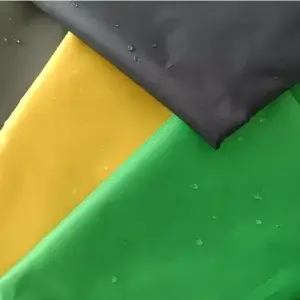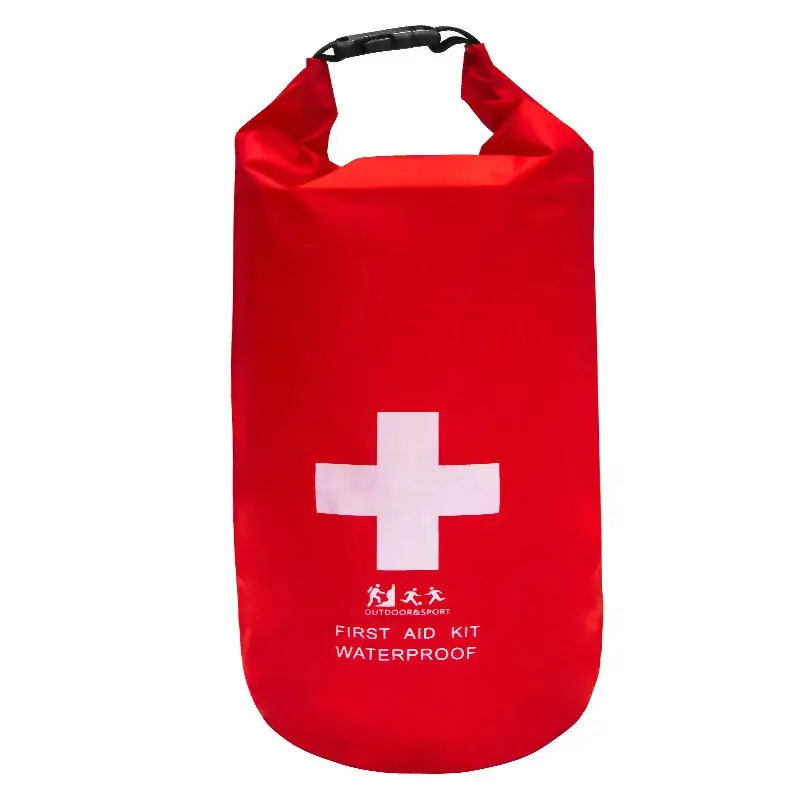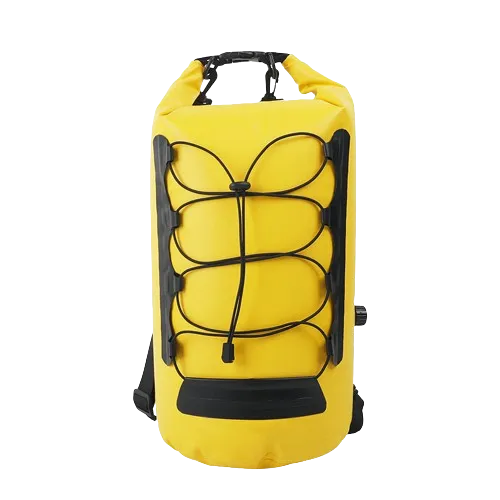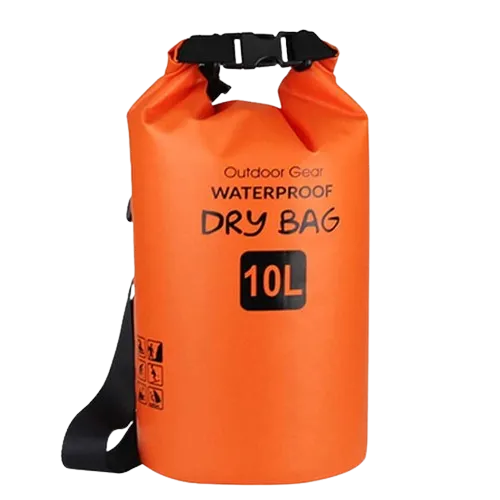Unveiling the Aquatic Armor: A Deep Dive into how Waterproof Coating Empowers Dry Bags
- Latest update

Written by Jason
Introduction
When venturing into the great outdoors, whether it be for hiking, camping, kayaking, or any other adventure, one essential item that should not be overlooked is a dry bag. A dry bag is a waterproof container designed to protect your valuable belongings from water damage.
It serves as a reliable safeguard against unpredictable weather conditions or accidental submersion. The importance of having a sturdy and reliable dry bag cannot be overstated when it comes to ensuring the safety and preservation of your gear.
Definition of Dry Bags and Their Importance in Outdoor Activities
A dry bag is a rugged, durable storage bag typically made from materials such as nylon or PVC that are highly resistant to water penetration. These bags are specifically engineered to keep the contents completely dry even when subjected to wet environments.
They come in various sizes and shapes, catering to different needs: from small pouches for personal items like wallets and cell phones to larger backpack-style bags capable of accommodating clothing, food supplies, and other essentials. The importance of dry bags in outdoor activities cannot be emphasized enough.
Whether you are embarking on a canoeing expedition down a rapid river or simply hiking through rainy terrain, the need to protect your equipment from water damage remains paramount. Imagine the frustration of reaching your campsite only to find that your clothes are drenched or electronic devices are rendered useless due to moisture infiltration.
Beyond protection from water damage caused by rain or immersion in bodies of water, dry bags also provide peace of mind by preventing damage from other elements like dust, sand, or dirt. This makes them ideal for all sorts of outdoor pursuits where unpredictable conditions may pose threats.
Importance of Waterproof Coating for Dry Bags

While the materials used in manufacturing dry bags contribute significantly to their waterproof properties, it is the application of a specialized waterproof coating that elevates their effectiveness. A waterproof coating acts as an additional layer of defense that enhances the bag’s ability to repel water and maintain a dry interior, even in the harshest conditions. The importance of a quality waterproof coating cannot be overstated.
It serves as a reliable barrier against moisture, preventing it from seeping through the fabric and compromising the contents of the bag. Without this protective measure, even the most robust materials would eventually succumb to water penetration.
Furthermore, a waterproof coating prolongs the lifespan of a dry bag by safeguarding it against wear and tear caused by prolonged exposure to water or harsh environmental factors such as UV radiation. By preventing degradation and damage, the waterproof coating ensures that your dry bag remains dependable for years to come.
Moreover, investing in a dry bag with an effective waterproof coating offers peace of mind during outdoor adventures. Knowing you have reliable protection for your gear allows you to focus on enjoying your activities without worrying about potential damage or loss due to water infiltration.
Overview of Waterproof Coating
Waterproof coating is a vital component in ensuring the effectiveness of dry bags, which are designed to keep our belongings safe and dry in various outdoor activities. The primary purpose of waterproof coating is to create a barrier that repels water, preventing it from penetrating the bag and protecting its contents from moisture damage.
The advent of waterproof coatings revolutionized the outdoor gear industry, as it allowed for the development of lightweight and durable materials that could withstand harsh weather conditions. These coatings are typically applied to the fabric or material used to make dry bags, providing them with enhanced water repellency.
Explanation of waterproof coating and its purpose
Waterproof coatings work by altering the surface properties of materials, reducing their ability to absorb water. They create a hydrophobic layer that repels water droplets on contact, preventing them from seeping into the bag’s interior.
This crucial feature ensures that even when exposed to heavy rain or accidental submersion in water bodies like rivers or lakes, our belongings remain dry and protected. In addition to repelling water, waterproof coatings also play a role in enhancing durability.
By sealing microscopic gaps between fibers or pores in the material, these coatings increase resistance against wear and tear caused by friction or environmental elements. This helps prolong the lifespan of dry bags and ensures they continue to perform optimally over time.
Different types of waterproof coatings available in the market
The market offers several types of waterproof coatings for dry bags, each with its unique properties and advantages. Two common types are silicone-based coatings and polyurethane (PU) coatings.
Silicone-based coatings
Silicone-based coatings are known for their excellent hydrophobic properties. These coatings form a thin film over the fabric surface, creating a barrier that repels water effectively.
Silicone is highly flexible and resistant to temperature changes, making it an ideal choice for dry bags used in extreme outdoor conditions. Moreover, it offers good UV stability, which helps prevent degradation of the coating under prolonged sun exposure.
However, silicone coatings can be less breathable compared to other options, which may result in condensation inside the bag if not properly managed. Additionally, they can be more expensive than alternative coatings due to the higher cost of raw materials.
See more, you can check there: Silicones for Coatings
Polyurethane (PU) coatings
Polyurethane (PU) coatings are another popular choice for waterproofing dry bags. These coatings offer a balance between water repellency and breathability.
PU has the advantage of being more breathable than silicone-based coatings, allowing air circulation inside the bag while still providing adequate protection against water ingress. Moreover, polyurethane is highly durable and resistant to abrasion and punctures.
This makes PU-coated dry bags suitable for rugged outdoor activities where gear may encounter rough terrains or sharp objects. One drawback of polyurethane coatings is their sensitivity to UV exposure over time.
Without proper UV inhibitors or protective layers, these coatings can degrade when exposed to sunlight for extended periods. Regular maintenance and storage practices are essential to maximize their longevity.
How Waterproof Coating Works for Dry Bags
Surface Tension and Repellency
Imagine standing in the rain and watching water droplets bead up and roll off your raincoat effortlessly. This phenomenon is due to a fascinating property of liquids called surface tension.
Surface tension is the force that causes liquid molecules to stick together, forming a kind of “skin” on the surface. When water comes into contact with a waterproof coating on a dry bag, it experiences an incredibly low surface tension, causing it to form into droplets.
These droplets are then repelled by the hydrophobic properties of the waterproof coating. Waterproof coatings possess hydrophobic characteristics, meaning they actively repel water.
The chemistry behind these coatings involves creating a layer that minimizes interactions between water molecules and the bag’s surface. By reducing cohesion between water molecules, the hydrophobic coating encourages them to form separate droplets instead of spreading out or penetrating through the material.
Breathability and Moisture Management
While keeping water out is essential for dry bags, equally important is allowing moisture from within the bag to escape. Breathability refers to the ability of a material or coating to allow air circulation while blocking water vapor from entering.
To achieve breathability in waterproof coatings for dry bags, microscopic pores are strategically incorporated into their structure. These pores are small enough to prevent liquid water from passing through but large enough to permit air molecules and moisture vapor to escape.
By enabling this exchange of air without compromising waterproofing capabilities, these coatings effectively prevent condensation buildup inside the bag. This balance between breathability and waterproofing ensures that your belongings remain dry while also avoiding issues like unpleasant odors or mildew formation caused by trapped moisture within your dry bag.
Seam Sealing and Reinforcement
While waterproof coatings play a significant role in keeping water out, certain parts of a dry bag are more susceptible to leakage. Seams, where two or more pieces of fabric join together, can be particularly vulnerable. To reinforce these weak points and ensure complete waterproofing, specialized techniques such as seam sealing and reinforcement are employed.
Seam sealing involves the application of waterproof tape or liquid sealants over the sewn seams of a dry bag. This process fills any microscopic gaps between stitches, preventing water from seeping through.
Additionally, some manufacturers use heat or pressure to bond the coating to the fabric near the seams, creating an extra layer of protection against leaks. Furthermore, areas prone to intense stress or potential abrasion like corners and straps undergo reinforced treatments during manufacturing.
Reinforcements such as additional layers of fabric or specialized coatings enhance durability and minimize the risk of leaks in these critical areas. By incorporating these seam sealing and reinforcement techniques into their design processes, manufacturers can offer dry bags that withstand even the harshest outdoor conditions while maintaining their waterproof integrity.
Understanding how waterproof coating works for dry bags provides valuable insights into their effectiveness in repelling water droplets through surface tension and hydrophobic properties. The balance between breathability and moisture management ensures that your belongings remain dry while allowing air circulation within the bag.
Seam sealing and reinforcement techniques further enhance durability by addressing vulnerable areas prone to leakage. By choosing a high-quality dry bag with effective waterproof coating technology, you can confidently embark on your outdoor adventures knowing that your gear will stay protected from unpredictable weather conditions
Factors Affecting Waterproof Coating Performance
Durability and Longevity
A top concern for individuals investing in dry bags is the durability and longevity of the waterproof coating. After all, a reliable coating ensures that your belongings remain protected even in the harshest conditions.
The effectiveness of a coating is determined by its ability to resist abrasion, punctures, and UV exposure. High-quality waterproof coatings are often engineered with advanced materials that provide exceptional strength against these elements.
To enhance durability, manufacturers may incorporate technologies like reinforced polymer layers or laminates that offer superior resistance to wear and tear. Such coatings have been rigorously tested through simulated scenarios to ensure they can withstand rigorous outdoor activities without compromising their waterproofing capabilities.
Impact Resistance against Abrasion, Punctures, and UV Exposure
Outdoor enthusiasts often encounter rugged terrains where their dry bags might encounter rough surfaces or sharp objects that could potentially damage the coating. A high-quality waterproof coating should demonstrate strong impact resistance against abrasion, preventing it from wearing off over time. Moreover, puncture resistance is crucial as it safeguards against accidental tears in the fabric caused by sharp rocks or other hazards encountered during outdoor adventures.
In addition to physical hazards, ultraviolet (UV) exposure can deteriorate coatings over time. Therefore, an effective waterproof coating should also possess excellent UV resistance properties to maintain its integrity under direct sunlight.
Maintenance Tips to Extend Lifespan
To maximize the lifespan of your dry bag’s waterproof coating, there are several maintenance practices you can adopt. Firstly, after each use in wet conditions or when exposed to saltwater environments like oceans or seas; rinse your bag thoroughly with fresh water to remove any residual substances that may corrode or degrade the coating over time.
Secondly, avoid storing your dry bag in direct sunlight for extended periods as prolonged exposure to UV rays can cause premature degradation. Instead, choose a cool, dry storage area away from direct sunlight.
Periodically apply a specialized waterproof coating renewer or spray recommended by the manufacturer. This helps replenish any lost waterproofing properties and provides an additional layer of protection to prolong the lifespan of your dry bag.
Environmental Considerations
Effectiveness under Different Weather Conditions (e.g., Rain, Snow, Extreme Heat)
A reliable waterproof coating should demonstrate consistent effectiveness across various weather conditions to ensure your belongings remain dry and secure.
Whether you are hiking in torrential rain or skiing in heavy snowfall, your dry bag’s coating must withstand these elements. The coating’s ability to repel water effectively during rainfall and resist snow absorption is crucial for maintaining the bag’s waterproof integrity.
Additionally, extreme heat can also pose challenges as it may weaken the coating’s structure over time. Therefore, opting for a high-quality waterproof coating that guarantees performance even in adverse weather conditions is essential for outdoor enthusiasts.
Eco-Friendly Options Available for Environmentally Conscious Consumers
As environmental consciousness rises among consumers, manufacturers have responded by developing eco-friendly options for waterproof coatings. These coatings aim to minimize the environmental impact while still delivering exceptional performance.
Eco-friendly coatings often utilize sustainable materials such as plant-based polymers or biodegradable compounds that break down naturally over time without polluting ecosystems. Choosing products with eco-labels certifying their sustainability helps ensure that your gear aligns with environmentally friendly practices without compromising on quality or performance.
Factors such as durability and longevity significantly impact the effectiveness of a waterproof coating on a dry bag. With proper maintenance techniques and careful consideration of environmental aspects like weather conditions and eco-friendliness, you can choose a high-quality dry bag with a reliable waterproof coating that will stand up against all challenges nature may throw at it.
Specialized Features and Innovations
Anti-fungal treatments to prevent mold or mildew growth
When it comes to protecting our belongings from water, we must also consider the potential growth of mold or mildew, which can be harmful and cause unpleasant odors. To combat this issue, manufacturers have introduced innovative anti-fungal treatments in waterproof coatings for dry bags.
These treatments incorporate additives that inhibit the growth of fungi, ensuring that your gear remains fresh and free from any unwanted microbial invaders. By incorporating anti-fungal properties into the coating, dry bags can now provide not only waterproof protection but also a hygienic environment for your belongings.
Reflective coatings for enhanced visibility during low-light conditions
Outdoor adventures often expose us to various lighting conditions, including low light or darkness. To enhance safety and visibility during these situations, some dry bag manufacturers have started integrating reflective coatings into their products.
These specialized coatings contain tiny light-reflecting particles that increase the bag’s visibility when exposed to a light source such as a flashlight or headlights. As a result, not only will your gear remain protected from water but you can also easily spot your dry bag in dimly lit environments and minimize any risks associated with reduced visibility.
Self-healing properties that repair minor damages automatically
Accidents happen even when we take utmost care of our gear. That’s why innovative self-healing properties have been incorporated into some waterproof coatings for dry bags.
These cutting-edge coatings contain microscopic capsules filled with adhesive materials that rupture upon impact with sharp objects, instantly sealing any puncture holes they encounter. This ingenious feature ensures that minor damages are repaired automatically without compromising the overall integrity of the waterproof coating or its ability to repel water effectively.
With self-healing properties in place, you can enjoy worry-free outdoor adventures without constantly fretting over potential damage to your gear.
Conclusion
The developments in waterproof coating technology have truly revolutionized the world of dry bags.
With specialized features and innovations like anti-fungal treatments, reflective coatings, and self-healing properties, dry bags now offer not only exceptional protection against water but also enhanced functionality and durability.
These advancements ensure that your gear remains safe from mold or mildew growth, increases visibility during low-light conditions for safer adventures, and even repairs minor damages on its own.
So, whether you’re trekking through a rainforest or rafting down a roaring river, you can have peace of mind knowing that your belongings are well-protected inside a high-quality waterproof dry bag. Embrace the possibilities offered by these advancements and let nothing dampen your outdoor experiences!
You may also be interested in below:





